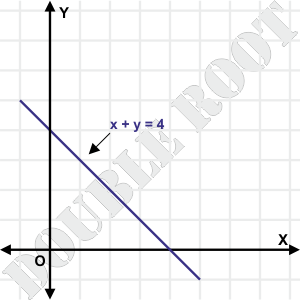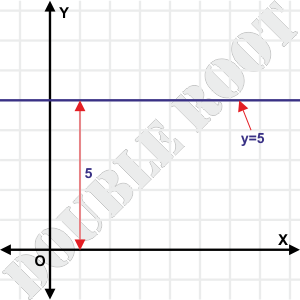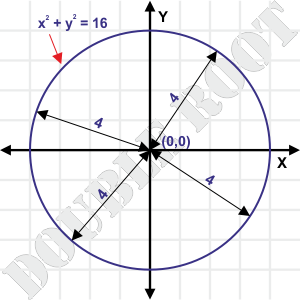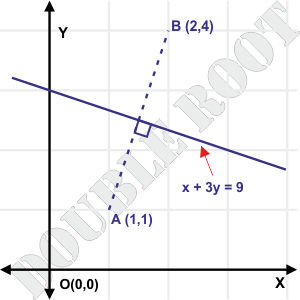This lesson will be focused on equation to a locus. I’ll again split it into two parts due to its length.
Equation to a Locus
A formal(ish) definition: “The equation of a curve is the relation which exists between the coordinates of all points on the curve, and which does not hold for any point not on the curve”.
Let us try to understand what this means.
If I write an equation, say x + y = 4 and tell you that this represents a line which looks like this…

… it means that if you take any random point lying on this line, take its x-coordinate and add it to the y-coordinate, you’ll always get 4 as the sum (because the equation says x + y = 4).
And if you take any other point not on the line, and add its coordinates together, you’ll never get the sum as 4. (For now, don’t worry about why x + y = 4 should look like a line, and not something different, e.g. a circle. We’ll see that later.)
Thus, finding out the equation to a locus means finding out the relation that holds true between the x and y coordinates of all points on the locus.
Let’s find out equations to all the loci we covered previously.
Example 1 Find the locus of the point moving on a plane which is at a fixed distance 5 units from a the X axis.
Let P(x, y) be the moving point. Now, the distance of this point from the X axis is its y-coordinate.
Since this distnace is given to be 5, we can write this relation in the form of an equation as
y = 5
Well, that’s it! We got the equation representing the locus.
Going in the reverse order, the equation y = 5 is the equation of the locus (or curve), every point on which has the y-coordinate as 5, or every point being at a distance of 5 units from the X-axis.

There is also another possibility of y = -5, also a line parallel to the X-axis, at a distance of 5 units, but lying below the axis.
Example 2 Find the locus of a point which is at a fixed distance 4 from the origin.
This locus (or path) was a circle. To find its equation, we’ll start by converting the given condition into a mathematical form, using the formulas we know.
Let P(x, y) be the moving point. It is given that OP = 4 (where O is the origin). How can we convert this into mathematical form?
OP is the distance between O and P which can be written as
\(\sqrt{(x-0)^2+(y-0)^2}\)
Hence, we can write
\(\sqrt{(x-0)^2+(y-0)^2}\) = 4
⇒ x2 + y2 = 16
Therefore, the equation to the locus under the given conditions is x2 + y2 = 16.

Example 3 Find the locus of a point such that it is equidistant from two fixed points, A(1, 1) and B(2, 4).
We had figure out that this was the perpendicular bisector of the line joining the points.
Now to the equation. Let P(x, y) be the moving point. According to the condition, PA = PB. This can be written as
\(\sqrt{(x-1)^2+(y-1)^2}=\sqrt{(x-2)^2+(y-4)^2}\).
After squaring both sides and simplifying, we get the equation as
x + 3y = 9

Lesson Summary
- The equation of a curve is the relation that holds true between the coordinates of every point on the curve, and no point that doesn’t lie on the curve.
- To find the equation to a locus, we start by converting the given conditions to mathematical equations.
That’s it for this part. Questions involving the locus will become a little more complicated as we proceed. The next part will cover the remaining examples.